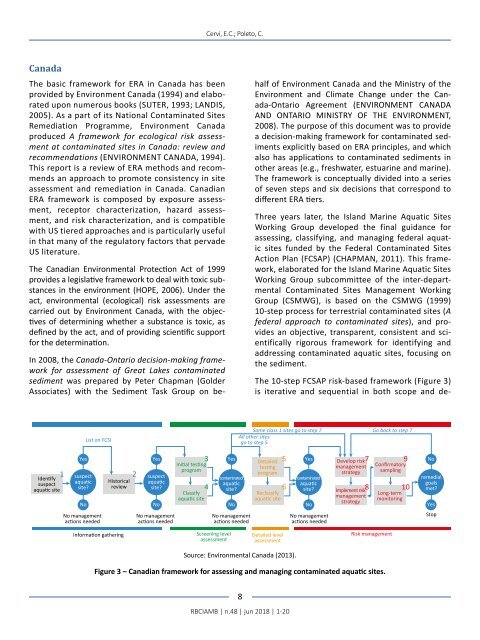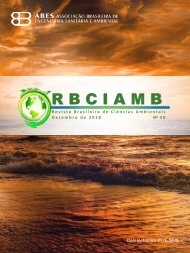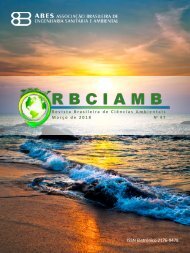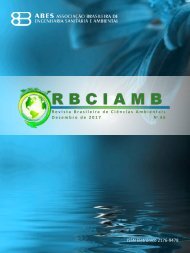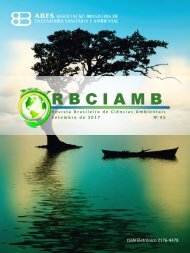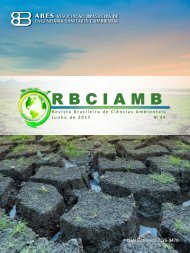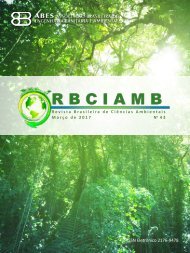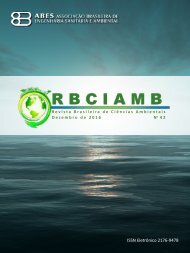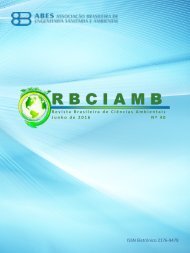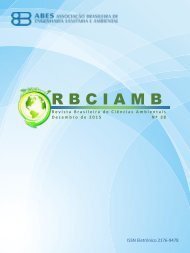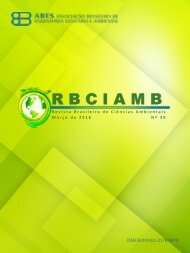Edição 48 RBCIAMB
Create successful ePaper yourself
Turn your PDF publications into a flip-book with our unique Google optimized e-Paper software.
Cervi, E.C.; Poleto, C.<br />
Canada<br />
The basic framework for ERA in Canada has been<br />
provided by Environment Canada (1994) and elaborated<br />
upon numerous books (SUTER, 1993; LANDIS,<br />
2005). As a part of its National Contaminated Sites<br />
Remediation Programme, Environment Canada<br />
produced A framework for ecological risk assessment<br />
at contaminated sites in Canada: review and<br />
recommendations (ENVIRONMENT CANADA, 1994).<br />
This report is a review of ERA methods and recommends<br />
an approach to promote consistency in site<br />
assessment and remediation in Canada. Canadian<br />
ERA framework is composed by exposure assessment,<br />
receptor characterization, hazard assessment,<br />
and risk characterization, and is compatible<br />
with US tiered approaches and is particularly useful<br />
in that many of the regulatory factors that pervade<br />
US literature.<br />
The Canadian Environmental Protection Act of 1999<br />
provides a legislative framework to deal with toxic substances<br />
in the environment (HOPE, 2006). Under the<br />
act, environmental (ecological) risk assessments are<br />
carried out by Environment Canada, with the objectives<br />
of determining whether a substance is toxic, as<br />
defined by the act, and of providing scientific support<br />
for the determination.<br />
In 2008, the Canada-Ontario decision-making framework<br />
for assessment of Great Lakes contaminated<br />
sediment was prepared by Peter Chapman (Golder<br />
Associates) with the Sediment Task Group on behalf<br />
of Environment Canada and the Ministry of the<br />
Environment and Climate Change under the Canada-Ontario<br />
Agreement (ENVIRONMENT CANADA<br />
AND ONTARIO MINISTRY OF THE ENVIRONMENT,<br />
2008). The purpose of this document was to provide<br />
a decision-making framework for contaminated sediments<br />
explicitly based on ERA principles, and which<br />
also has applications to contaminated sediments in<br />
other areas (e.g., freshwater, estuarine and marine).<br />
The framework is conceptually divided into a series<br />
of seven steps and six decisions that correspond to<br />
different ERA tiers.<br />
Three years later, the Island Marine Aquatic Sites<br />
Working Group developed the final guidance for<br />
assessing, classifying, and managing federal aquatic<br />
sites funded by the Federal Contaminated Sites<br />
Action Plan (FCSAP) (CHAPMAN, 2011). This framework,<br />
elaborated for the Island Marine Aquatic Sites<br />
Working Group subcommittee of the inter-departmental<br />
Contaminated Sites Management Working<br />
Group (CSMWG), is based on the CSMWG (1999)<br />
10-step process for terrestrial contaminated sites (A<br />
federal approach to contaminated sites), and provides<br />
an objective, transparent, consistent and scientifically<br />
rigorous framework for identifying and<br />
addressing contaminated aquatic sites, focusing on<br />
the sediment.<br />
The 10-step FCSAP risk-based framework (Figure 3)<br />
is iterative and sequential in both scope and de-<br />
List on FCSI<br />
Some class 1 sites go to step 7<br />
All other sites<br />
go to step 5<br />
Go back to step 7<br />
Identify<br />
suspect<br />
aquatic site<br />
Yes<br />
1 2<br />
suspect<br />
aquatic<br />
site?<br />
No<br />
Historical<br />
review<br />
Yes<br />
suspect<br />
aquatic<br />
site?<br />
No<br />
Initial testing<br />
program<br />
Classify<br />
aquatic site<br />
3<br />
4<br />
Yes<br />
contaminated<br />
aquatic<br />
site?<br />
No<br />
Detailed<br />
testing<br />
program<br />
Reclassify<br />
aquatic site<br />
5<br />
6<br />
Yes<br />
contaminated<br />
aquatic<br />
site?<br />
No<br />
7<br />
Develop risk<br />
management<br />
strategy<br />
8<br />
Implement risk<br />
management<br />
strategy<br />
9<br />
Confirmatory<br />
sampling<br />
Long-term<br />
monitoring<br />
10<br />
No<br />
remedial<br />
goals<br />
met?<br />
Yes<br />
No management<br />
actions needed<br />
No management<br />
actions needed<br />
No management<br />
actions needed<br />
No management<br />
actions needed<br />
Stop<br />
Information gathering<br />
Screening level<br />
assessment<br />
Detailed level<br />
assessment<br />
Risk management<br />
Source: Environmental Canada (2013).<br />
Figure 3 – Canadian framework for assessing and managing contaminated aquatic sites.<br />
8<br />
<strong>RBCIAMB</strong> | n.<strong>48</strong> | jun 2018 | 1-20


